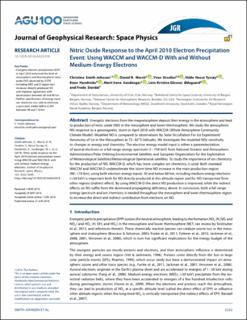Nitric Oxide Response to the April 2010 Electron Precipitation Event: Using WACCM and WACCM‐D With and Without Medium‐Energy Electrons
Smith-Johnsen, Christine; Marsh, Daniel R.; Orsolini, Yvan; Tyssøy, Hilde Nesse; Hendrickx, Koen; Sandanger, Marit Irene J.; Ødegaard, Linn-Kristine Glesnes; Stordal, Frode
Peer reviewed, Journal article
Published version
Permanent lenke
https://hdl.handle.net/11250/2723093Utgivelsesdato
2018Metadata
Vis full innførselSamlinger
- Artikler [235]
- Publikasjoner fra Cristin - FHS [161]
Originalversjon
Journal of Geophysical Research - Space Physics. 2018, 123 5232-5245. 10.1029/2018JA025418Sammendrag
Energetic electrons from the magnetosphere deposit their energy in the atmosphere and lead to production of nitric oxide (NO) in the mesosphere and lower thermosphere. We study the atmospheric NO response to a geomagnetic storm in April 2010 with WACCM (Whole Atmosphere Community Climate Model). Modeled NO is compared to observations by Solar Occultation For Ice Experiment/Aeronomy of Ice in the Mesosphere at 72–82°S latitudes. We investigate the modeled NOs sensitivity to changes in energy and chemistry. The electron energy model input is either a parameterization of auroral electrons or a full range energy spectrum (1–750 keV) from National Oceanic and Atmospheric Administration/Polar Orbiting Environmental Satellites and European Organisation for the Exploitation of Meteorological Satellites/Meteorological Operational satellites. To study the importance of ion chemistry for the production of NO, WACCM‐D, which has more complex ion chemistry, is used. Both standard WACCM and WACCM‐D underestimate the storm time NO increase in the main production region (90–110 km), using both electron energy inputs. At and below 80 km, including medium‐energy electrons (>30 keV) is important both for NO directly produced at this altitude region and for NO transported from other regions (indirect effect). By using WACCM‐D the direct NO production is improved, while the indirect effects on NO suffer from the downward propagating deficiency above. In conclusion, both a full range energy spectrum and ion chemistry is needed throughout the mesosphere and lower thermosphere region to increase the direct and indirect contribution from electrons on NO.
